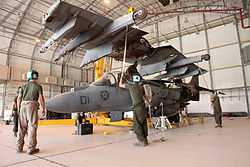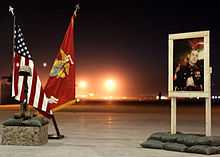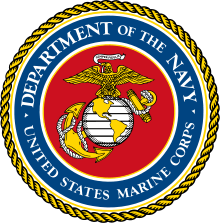September 2012 Camp Bastion raid
Coordinates: 31°30′45″N 64°07′53″E / 31.5124°N 64.1315°E
| September 2012 Camp Bastion raid | |
|---|---|
| Part of the War in Afghanistan (2001–present) | |
 Marines from VMA-211 at Camp Bastion, two weeks before the attack. | |
| Type | Suicide attack |
| Location | Helmand Province, Afghanistan |
| Target | Camp Bastion |
| Date | 14 September 2012 22:00 (GMT+4:30 Kabul (UTC)) |
| Casualties | |
| ||||||
The September 2012 Camp Bastion raid was a Taliban raid that killed two United States Marine Corps (USMC) service personnel and destroyed or severely damaged eight USMC McDonnell Douglas AV-8B Harrier IIs at Camp Bastion in Afghanistan's Helmand province on the night of 14 September 2012.[1]
The raid
The raid was a complex and coordinated assault by 19 Taliban fighters dressed in United States Army uniforms using several types of weapons which took place on the eastern side of Camp Bastion near to the USMC aircraft hangars at 22:00 local time (17:30 GMT). The assault team penetrated the perimeter of the camp, guarded by troops from Tonga, and separated into three teams to carry out the attack.[2] One team engaged a group of USMC mechanics from VMM-161 who were in the area; the same team had attacked the aircraft refueling stations. Another group attacked the aircraft, and the last group was engaged at the base cryogenics compound. The group that attacked the aircraft attached explosive charges to several of the jets, then fired rocket-propelled grenades (RPGs) at several others.[3]
The attackers were defeated after a four-hour firefight by USMC personnel and No. 51 Squadron RAF Regiment along with helicopter support supplied by a British AgustaWestland Apache, a USMC Bell AH-1W SuperCobra and machine-gun equipped UH-1s, which took off while under fire from the insurgents. The RAF troops, who were located on the opposite side of the huge base, arrived at the scene approximately 12 minutes after the attack began.[3] Some of the pilots and maintainers from VMA-211 also fought as infantrymen, killing one and injuring another who was trying to fire an RPG at a group defending the flight line, the first time the squadron had done this since the Battle of Wake Island after most of their planes had been destroyed in a surprise Japanese raid.[4] Marines from VMM-161 killed one group of five Taliban with small arms fire as they tried to advance down the flightline area. A second group of five insurgents were flushed out of hiding hours later and shot by No. 51 Squadron RAF Regiment and USMC forces in a compound near their entry point. [5] The final group of five insurgents was detected near the flightline hours later and four were killed by gunfire from the RAF Quick Reaction Force and hovering helicopters. The fifth insurgent was injured and captured.[6]
During the early portion of the fighting, the Marine Attack Squadron 211 (VMA-211) squadron commander, Lieutenant Colonel Christopher Raible, 40, was killed while personally leading an attack on the infiltrators, armed only with his pistol.[7][8][9] Killed nearby was USMC mechanic Sergeant Bradley Atwell, 27, while taking cover behind Ground Support Equipment on the Flight Line. Atwell and Raible were killed by a single RPG round which exploded in the air above them.[3] Eight coalition troops and one civilian contractor were injured. Six AV-8B Harrier IIs and a United States Air Force C-130 were destroyed and another two Harriers severely damaged.[10][11][12][13] Three refuelling stations were destroyed and six soft-skin aircraft hangars damaged.[14]

Aftermath
The attack was described as "the worst loss of U.S. airpower in a single incident since the Vietnam War."[15] The eight destroyed or damaged aircraft constituted six percent of the USMC's inventory of Harrier attack jets. Normal attrition of the USMC's Harrier jets is around two airframes a year.[16] To replace the aircraft lost in the attack, the USMC deployed 14 Harriers to Afghanistan within 36 hours of the raid.[17]
The Taliban claimed that the raid was in response to the film Innocence of Muslims, and have also stated that Prince Harry, who was stationed at the base at the time, was the target of the attack.[18]
The BBC claimed that the attack "bore all the hallmarks of the Haqqani network".[8] The ISAF claimed a week later that it had captured one of the raid's planners.[6]
USMC response
Marine Major General Charles M. Gurganus was in charge of the base defenses and had reduced the number of Marines patrolling the base perimeter from 325 to 100 one month before the attack. After pressure from the families of those killed or injured in the battle, the US Senate put Gurganus' promotion to Lieutenant General on hold.[10] On 30 September 2013, USMC Commandant James F. Amos announced that he had found Gurganus and USMC Major General Gregg A. Sturdevant to be accountable for failures of the base defenses during the raid. Sturdevant was in charge of USMC aviation assets in that region of Afghanistan. Both were directed to retire from the USMC immediately at their current ranks of Major General.[19]
The Marine Corps stated Gurganus "bore final accountability for the lives and equipment under his charge," and he "made an error in judgment when conducting his risk assessment of the enemy's capabilities and intentions." Sturdevant, the USMC said, "did not adequately assess the force protection situation".[20]
Both men will retire honorably and with full benefits. According to NBC News, a senior U.S. defense official remarked that if Gurganus was not a general he would have faced a court martial, which would have prevented retirement with full benefits. "Marines are dead and six aircraft were destroyed. A Lance Corporal would fry for a lot less than that," NBC quoted the official saying.[20]
British response
The British House of Commons Cross-party Defence Committee investigated the incident, and published their report on 16 April 2014. They concluded that "only 11 out of 24 guard towers on the base had been manned", and that "British commanders must bear a degree of responsibility for... systemic failures and associated reputational damage".[21]
References
- ↑ Rubin, Alissa (16 September 2012). "Audacious Raid on NATO Base Shows Taliban’s Reach". The New York Times. Retrieved 16 September 2012.
- ↑ Aikens, Matthieu, "Enemy Inside the Wire: The Untold Story of the Battle of Bastion", GQ, September 2013, retrieved 6 September 2013. In the weeks preceding the attack, US Marines had sometimes found the Tongan guards sleeping on duty.
- ↑ 3.0 3.1 3.2 Lamb, Christina, Nicola Smith, and Tim Ripley, "Bastion Raid Signals Birth Of Taliban SAS", London Sunday Times, 23 September 2012, p. 23
- ↑ Timperlake, Ed (21 September 2012). "Tribute To Camp Bastion Fallen; Taliban Targeted Harriers, Their 'Biggest Threat'". AOL Defense. Retrieved 24 September 2012.
- ↑ https://www.gov.uk/government/news/raf-force-protection-wing-defends-camp-bastion-during-taliban-attack
- ↑ 6.0 6.1 Kovach, Gretel C., "'Surreal' Attack At Camp Bastion", U-T San Diego, 7 October 2012, p. 1
- ↑ Hamill, Sean D. (14 October 2012). "Irwin Marine killed in Afghanistan honored at memorial service for his brave actions". Pittsburgh Post-Gazette. Retrieved 11 August 2013.
- ↑ 8.0 8.1 Quentin Sommerville (24 September 2012). "Camp Bastion assault: Details emerge of Taliban attack". British Broadcasting Corporation(BBC). Retrieved 24 September 2012.
- ↑ Londono, Ernesto, "Marine's Actions Described As Heroic", Washington Post, 24 September 2012, p. 7
- ↑ 10.0 10.1 Aikens, Matthieu, "Enemy Inside the Wire: The Untold Story of the Battle of Bastion", GQ, September 2013, retrieved 6 September 2013.
- ↑ WPXI (17 September 2012). "CMU graduate killed in attack on U.S. military base in Afghanistan". WPXI. Retrieved 24 September 2012.
- ↑ Justin Fishel; Jennifer Griffin (15 September 2012). "Deadly attack on base in Afghanistan destroys five aircraft, damages 3". Fox News. Retrieved 20 September. Check date values in:
|accessdate=(help) - ↑ BBC (15 September 2012). "US marines killed in Afghan attack on Camp Bastion". BBC. Retrieved 16 September 2012.
- ↑ ISAF (16 September 2012). "ISAF provides additional details on Camp Bastion attack". International Security Assistance Force (ISAF). Retrieved 17 September 2012.
- ↑ John D. Gresham (20 September 2012). "Attack on Camp Bastion: The Destruction of VMA-211". Defense Media Network. Retrieved 24 September 2012.
- ↑ Brancato, Kevin, and Christine Ryan, "Few Options For Replacing Destroyed Harrier Jets", Bloomberg Government, 2 October 2012. The Harrier is no longer in production, but is expected to be replaced in the USMC by the F-35 beginning in 2020.
- ↑ Majumdar, Dave (10 October 2012). "Marines surged Harriers to Afghanistan within 36 hours of attack". The DEW Line. Retrieved 14 October 2012.
- ↑ "Taliban take credit for British base attack". Al Jazeera. 15 September 2012. Retrieved 15 September 2012.
- ↑ Burns, Robert, Associated Press, "Two Marine generals fired in wake of brazen Taliban attack on Camp Bastion", Stars and Stripes, 30 September 2013, retrieved 1 October 2013.
- ↑ 20.0 20.1 Kube, Courtney. "Two senior Marine generals forced to retire over deadly Afghan attack". World News on NBCNEWS.com. National Broadcasting Company. Retrieved 1 October 2013.
- ↑ More details in this article, 'Camp Bastion Attack revealed High Level-Complacentcy' (accessed 16 April 2014)
External links
- The Telegraph - British troops help fight off Taliban attack on Afghan military base housing Prince Harry
- Boston.com - 2 Marines killed in attack in southern Afghanistan
- Defense Video & Imagery Distribution System - ISAF provides additional details on Camp Bastion attack
- Washington Post - Slain Marine commander’s actions called heroic
| ||||||||||||||||||||||
| ||||||||||||||||||||||||||||||||||||||||||||
| |||||||||||||||||||||||||||||||||
| ||||||||||||||||||||||||||||||||||||||||||||||
| ||||||||||||||||||||||

